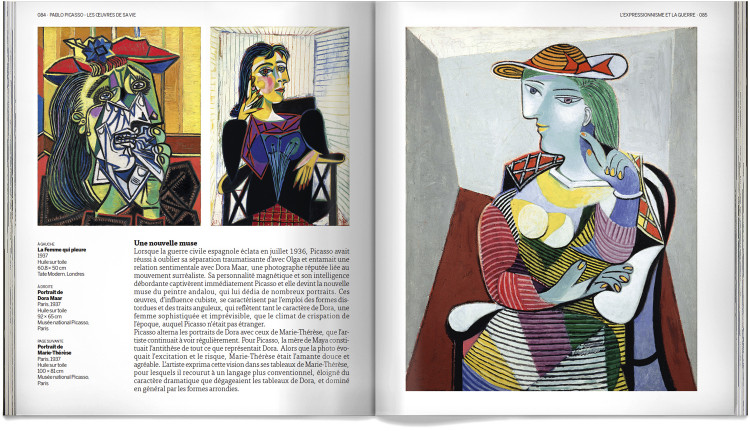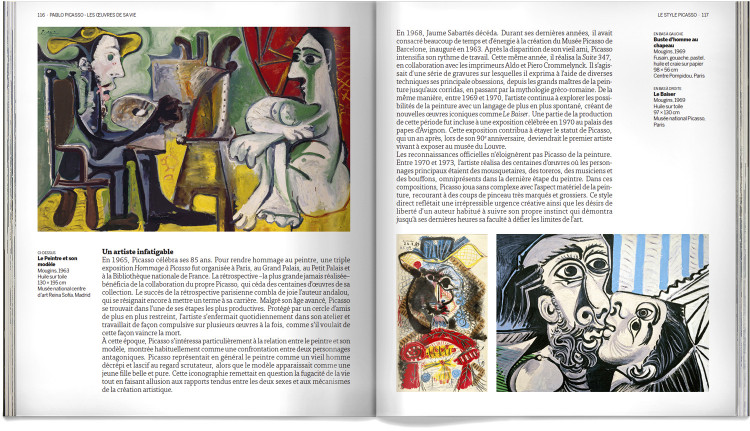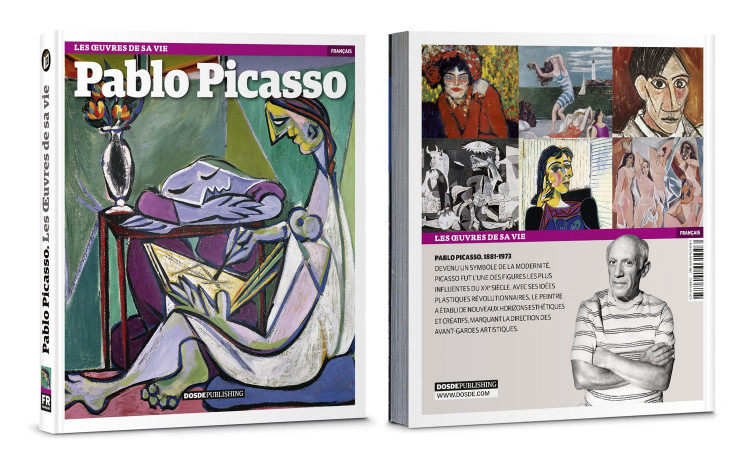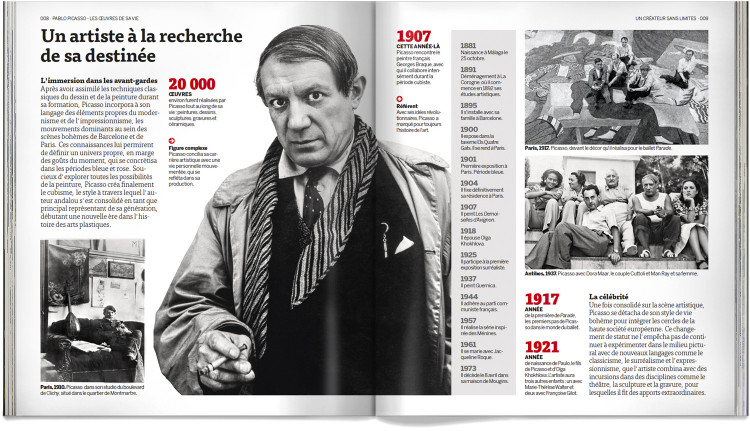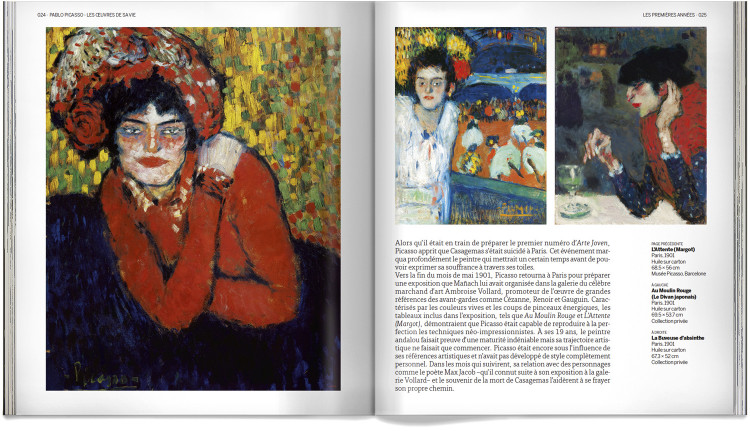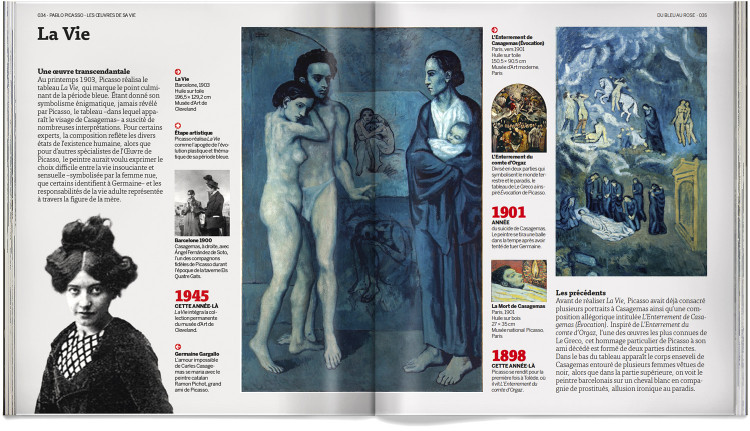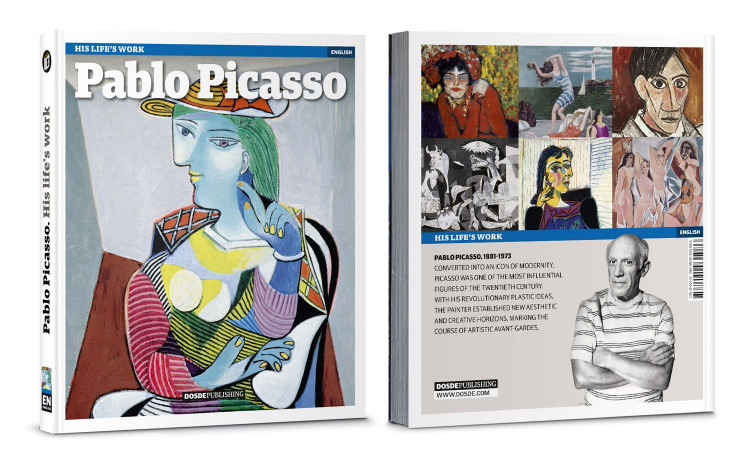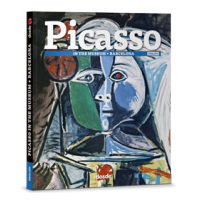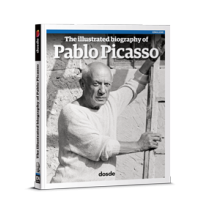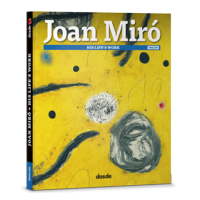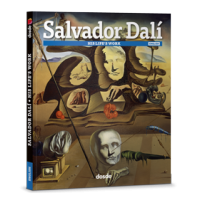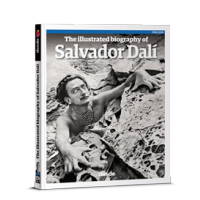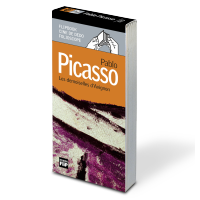Picasso
His life's work
RETURN
About the book Picasso, his life's work
The book explores in detail the works that Picasso carried out throughout his life, explaining each of his creative periods. As we turn its pages we can find out about the background of Picasso's most important pictures and discover what events influenced the painter's stylistic evolution, considered one of the key references of contemporary art.
Divided into eight chapters, the book Picasso, his life's work is organised in a chronological way to explore the artist's career, from the works he carried out during his adolescence up to his final artistic experiments. By means of this layout, this book published by Dosde allows us to distinguish Pablo's different creative periods, as well as the relationship between the works and the historical and cultural context of each period.
This fascinating book packed with information about the works of Pablo Picasso includes more than 170 pictures, amongst which include historical photographs as well as pictures of the original paintings.
The book has been produced with ISO colour certifications which guarantee that the printed colour is practically equal to the original work. It has also been certified by the Picasso Administration through Vegap, which verifies it as a book of rigorous quality. A characteristic distinguishing Dosde's book on Picasso is that it is focused on the works of Picasso in the Barcelonan museum dedicated to his work.
Divided into eight chapters, the book Picasso, his life's work is organised in a chronological way to explore the artist's career, from the works he carried out during his adolescence up to his final artistic experiments. By means of this layout, this book published by Dosde allows us to distinguish Pablo's different creative periods, as well as the relationship between the works and the historical and cultural context of each period.
This fascinating book packed with information about the works of Pablo Picasso includes more than 170 pictures, amongst which include historical photographs as well as pictures of the original paintings.
The book has been produced with ISO colour certifications which guarantee that the printed colour is practically equal to the original work. It has also been certified by the Picasso Administration through Vegap, which verifies it as a book of rigorous quality. A characteristic distinguishing Dosde's book on Picasso is that it is focused on the works of Picasso in the Barcelonan museum dedicated to his work.
Visual Edition
Picasso
It includes exclusive digital content
Made with environmentally friendly paper
Official licensed product
Multilanguage: Available in 6 languages
About the book Picasso, his life's work
The book explores in detail the works that Picasso carried out throughout his life, explaining each of his creative periods. As we turn its pages we can find out about the background of Picasso's most important pictures and discover what events influenced the painter's stylistic evolution, considered one of the key references of contemporary art.
Divided into eight chapters, the book Picasso, his life's work is organised in a chronological way to explore the artist's career, from the works he carried out during his adolescence up to his final artistic experiments. By means of this layout, this book published by Dosde allows us to distinguish Pablo's different creative periods, as well as the relationship between the works and the historical and cultural context of each period.
This fascinating book packed with information about the works of Pablo Picasso includes more than 170 pictures, amongst which include historical photographs as well as pictures of the original paintings.
The book has been produced with ISO colour certifications which guarantee that the printed colour is practically equal to the original work. It has also been certified by the Picasso Administration through Vegap, which verifies it as a book of rigorous quality. A characteristic distinguishing Dosde's book on Picasso is that it is focused on the works of Picasso in the Barcelonan museum dedicated to his work.
Divided into eight chapters, the book Picasso, his life's work is organised in a chronological way to explore the artist's career, from the works he carried out during his adolescence up to his final artistic experiments. By means of this layout, this book published by Dosde allows us to distinguish Pablo's different creative periods, as well as the relationship between the works and the historical and cultural context of each period.
This fascinating book packed with information about the works of Pablo Picasso includes more than 170 pictures, amongst which include historical photographs as well as pictures of the original paintings.
The book has been produced with ISO colour certifications which guarantee that the printed colour is practically equal to the original work. It has also been certified by the Picasso Administration through Vegap, which verifies it as a book of rigorous quality. A characteristic distinguishing Dosde's book on Picasso is that it is focused on the works of Picasso in the Barcelonan museum dedicated to his work.
Videos Picasso
No reviews yet.
Additional Information
- Additional Information
- Subtitle: His life's work
- Weight (g): 500
- Binding: Paperback
- Size (cm): 16,5 x 20,5
- Author: Dosde
- Pages: 0
- Edition: Visual Edition
Biography of Picasso
Born in 1881 in the Andalusian city of Malaga, Pablo Ruiz Picasso is considered the most influential artist of the twentieth century. Throughout his career, the painter showed an incredible flair for creativity, which allowed him to go beyond the conventional limits of his time to be at the forefront of the avant-garde.
Picasso already demonstrated his innate gift for painting from a very early age, under the guidance of his father. After joining Barcelona's bohemian scene, the artist moved to Paris, the capital of cultural innovation, which was the perfect setting for him to explore forms of expression outside the pictorial medium.
Converted into a celebrity for his contributions to movements such as Cubism, Picasso spent the last years of his life in the south of France. True to his restless spirit, the painter never ceased to reinvent himself until his death in 1973 in Mougins, leaving behind a legacy of incalculable value that has helped shape the style and vision of several generations of artists.
The entire career of this visionary creator is analysed in an exhaustive manner in the diverse books on Pablo Picasso published by Dosde.
Picasso’s close relationship with art commenced during his childhood. Mentored by his father –José Ruiz Blasco, a painter from Malaga who worked as a teacher at the School of Fine Arts and as a curator at the Municipal Museum– the future creator of Cubism soon became familiar with the basic techniques of drawing and painting.
His innate talent, perfected by the classes he received in the Fine Arts Schools in La Coruña and Barcelona, allowed him to master the academic language of the period with ease when he was still just an adolescent, as is reflected by Picasso's works during these years, which include Science and Charity.
After assimilating everything the teachers could teach him, Picasso started moving in the bohemian circles of Barcelona, where he learned about the latest and most innovative artistic trends. The presence of Picasso on the bohemian scene was immediately reflected in his work. The painter left behind the realism that had characterised his academic period in order to evolve towards a more spontaneous language.
Following in the footsteps of his more experienced companions, in 1900 Picasso travelled to Paris accompanied by Casagemas to discover all the latest artistic trends, taking advantage of the fact that one of his paintings had been selected for an exhibition organized within the framework of the Universal Exposition of that year.
During his first stay in the French capital, Picasso could observe the behaviour of the archetypal characters of bohemian Paris. All these experiences were reflected by vibrant, colourful Picasso works such as Le Moulin de la Galette and In the Dressing Room, which were inspired by the influence of greats such as Degas, Toulouse-Lautrec and Van Gogh, whose paintings Picasso had been able to see on his visits to the city’s galleries.
During this period the painter made the colour blue his main sign of identity, whilst at the same time focusing on depicting characters excluded by society.
Provided with deep symbolic meaning, the works Picasso created during this period were impregnated with bitter feelings such as despair and uprooting, which Picasso was experiencing at first-hand due to his precarious economic situation at the time.
When his circumstances changed, the painter became detached from all that pessimism and instead turned to a much more agreeable and optimistic style, which was dominated by pink, rose tones and positive images. Picasso's paintings continued to exude a feeling of melancholy, but this time they were deprived of the pathos so typical of the Blue Period.
Picasso also began to introduce characters from the circus world, such as harlequins and acrobats, whom the artist knew well thanks to his frequent visits to the Médrano Circus, which was located just a few blocks away from his art studio.
The obsession of western painting to reproduce reality as closely as possible began to be questioned at the end of the nineteenth century by several artists who preferred to portray a more subjective view of the world on their canvases, in tune with an era marked by social transformations and scientific advances.
This search for alternatives to the pictorial techniques prevailing since the Renaissance was pushed to the limit by Picasso, who definitively broke with tradition thanks to Cubism, a style that allowed to capture several points of view simultaneously.
His Cubist period started in 1907 with Les Demoiselles d'Avignon, which would convert into one of Picasso's most important works, and would continue in the following years with numerous experiments carried out in collaboration with the painter George Braque.
Misunderstood at first by many of his companions, the revolutionary experiments of the Malagan painter were a turning point in the history of art. Cubism opened up a new world of possibilities, at the same time as it established the course of the avant-garde, generating a chain reaction that led to the emergence of other revolutionary and ground-breaking art movements such as Futurism and Constructivism.
After heading the cubist revolution, during the initial period of the postwar period the painter chose to renew his artistic style by drawing on the models of Antiquity and the Renaissance as his source of inspiration.
The change in direction to Classicism was evident in compositions such as Three Women at the Fountain and Pan's Flute, works in which Picasso recuperated his interest for figures with well-defined outlines. This evolution occurred at the same time as Picasso was making his first forays into the world of theatre, where the artist was able to establish personal relationships that led him to adopt a lifestyle in accordance with the new direction his work was taking.
The Surrealists defended the supremacy of the world of dreams and irrational impulses. They therefore believed that artists could achieve total creative freedom by ignoring the filters imposed by reason in order to obtain direct access to the subconscious.
Guided by his craving for experimentation, Picasso soon became drawn to Surrealism, which provided him with new tools that would help express his preoccupations. Even so, the painter from Malaga avoided being formally attached to the movement in order that he could maintain his independence and develop his own artistic vision without any outside interference.
This autonomy is made evident in the works that Picasso painted from 1925, amongst which are canvases such as The Dance, a unique reinterpretation of the theme of the Three Graces in which the author radically broke with the classicist language of recent years. Picasso endowed the figures with a macabre appearance, inbuing them with unusual violence.
The Dance was reproduced by André Breton in the fourth issue of La Révolution Surréaliste, published in July 1925, which also included for the first time a photograph of Les Demoiselles d’Avignon. This meant that the affinity between Picasso and Surrealism became openly visible.
The painter’s direct involvement in the events and his personal experiences produced an immediate impact on his work. The turbulence and strife of this period became a powerful source of inspiration for the Andalusian artist, who set out to reflect on canvas all his anxiety and preoccupation by creating expressionist style compositions that would allow him to demonstrate once again his ability to develop on and expand his artistic horizons.
Guernica dates back to this period, one of Picasso's most well known works. The painting was a commission for the pavilion that was going to represent Spain in the International Exhibition of Paris of 1937, and it became a universal symbol of tºhe horror of war. Its source of inspiration was the bombing of the Basque municipality of Guernica, one of the most dramatic episodes of the Spanish Civil War.
Proving that his imagination was not yet exhausted, Picasso threw himself into his work and continued developing a personal universe, completely alien to the new avant-garde trends, such as Informalism and Abstract Expressionism.
He succeeded in embarking on an extremely fertile creative period by freeing himself of every preestablished stylistic model and experimenting with all the techniques he had at his disposal.
This period includes the pictorial cycles based on the paintings of the great masters of the history of art, such as Las Meninas by Velázquez, The Algerian Girls by Delacroix and Le Déjeuner sur l’herbe by Manet.
Other important works of Picasso from the same period include La Joie de vivre, carried out during his productive stay in Antibes, along with his wall paintings in the Temple of Peace in Vallauris, where the artist showed his political compromise, exp career, during which Picasso dedicated himself to series based on a single concept, using a spontaneous style and full of vitality, a perfect synthesis of his unique and ground-breaking vision of art.
Picasso already demonstrated his innate gift for painting from a very early age, under the guidance of his father. After joining Barcelona's bohemian scene, the artist moved to Paris, the capital of cultural innovation, which was the perfect setting for him to explore forms of expression outside the pictorial medium.
Converted into a celebrity for his contributions to movements such as Cubism, Picasso spent the last years of his life in the south of France. True to his restless spirit, the painter never ceased to reinvent himself until his death in 1973 in Mougins, leaving behind a legacy of incalculable value that has helped shape the style and vision of several generations of artists.
The entire career of this visionary creator is analysed in an exhaustive manner in the diverse books on Pablo Picasso published by Dosde.
The early years
Picasso’s close relationship with art commenced during his childhood. Mentored by his father –José Ruiz Blasco, a painter from Malaga who worked as a teacher at the School of Fine Arts and as a curator at the Municipal Museum– the future creator of Cubism soon became familiar with the basic techniques of drawing and painting.His innate talent, perfected by the classes he received in the Fine Arts Schools in La Coruña and Barcelona, allowed him to master the academic language of the period with ease when he was still just an adolescent, as is reflected by Picasso's works during these years, which include Science and Charity.
After assimilating everything the teachers could teach him, Picasso started moving in the bohemian circles of Barcelona, where he learned about the latest and most innovative artistic trends. The presence of Picasso on the bohemian scene was immediately reflected in his work. The painter left behind the realism that had characterised his academic period in order to evolve towards a more spontaneous language.
Following in the footsteps of his more experienced companions, in 1900 Picasso travelled to Paris accompanied by Casagemas to discover all the latest artistic trends, taking advantage of the fact that one of his paintings had been selected for an exhibition organized within the framework of the Universal Exposition of that year.
During his first stay in the French capital, Picasso could observe the behaviour of the archetypal characters of bohemian Paris. All these experiences were reflected by vibrant, colourful Picasso works such as Le Moulin de la Galette and In the Dressing Room, which were inspired by the influence of greats such as Degas, Toulouse-Lautrec and Van Gogh, whose paintings Picasso had been able to see on his visits to the city’s galleries.
From blue to rose
During his second stay in Paris, Picasso left behind his initial enthusiasm for the attractions of the French capital to enter an introspective period. Tormented by the memory of the tragic suicide of his friend Carles Casagemas, the Malagan artist developed a new pictorial style with a marked melancholic character that was a true reflection of his present state of mind.During this period the painter made the colour blue his main sign of identity, whilst at the same time focusing on depicting characters excluded by society.
Provided with deep symbolic meaning, the works Picasso created during this period were impregnated with bitter feelings such as despair and uprooting, which Picasso was experiencing at first-hand due to his precarious economic situation at the time.
When his circumstances changed, the painter became detached from all that pessimism and instead turned to a much more agreeable and optimistic style, which was dominated by pink, rose tones and positive images. Picasso's paintings continued to exude a feeling of melancholy, but this time they were deprived of the pathos so typical of the Blue Period.
Picasso also began to introduce characters from the circus world, such as harlequins and acrobats, whom the artist knew well thanks to his frequent visits to the Médrano Circus, which was located just a few blocks away from his art studio.
The Cubist revolution
The obsession of western painting to reproduce reality as closely as possible began to be questioned at the end of the nineteenth century by several artists who preferred to portray a more subjective view of the world on their canvases, in tune with an era marked by social transformations and scientific advances.This search for alternatives to the pictorial techniques prevailing since the Renaissance was pushed to the limit by Picasso, who definitively broke with tradition thanks to Cubism, a style that allowed to capture several points of view simultaneously.
His Cubist period started in 1907 with Les Demoiselles d'Avignon, which would convert into one of Picasso's most important works, and would continue in the following years with numerous experiments carried out in collaboration with the painter George Braque.
Misunderstood at first by many of his companions, the revolutionary experiments of the Malagan painter were a turning point in the history of art. Cubism opened up a new world of possibilities, at the same time as it established the course of the avant-garde, generating a chain reaction that led to the emergence of other revolutionary and ground-breaking art movements such as Futurism and Constructivism.
The Classicism period
The First World War plunged European society into such chaos that at the end of the war there was a strong desire and need to restore lost order. This longing to recuperate the values that had disappeared during the strife also affected the field of art. The development of the avant-garde movements slowed down and the constant search for innovation was replaced instead by the attachment to the equilibrium and security of the classical roots of art. Pablo Picasso became part of this trend.After heading the cubist revolution, during the initial period of the postwar period the painter chose to renew his artistic style by drawing on the models of Antiquity and the Renaissance as his source of inspiration.
The change in direction to Classicism was evident in compositions such as Three Women at the Fountain and Pan's Flute, works in which Picasso recuperated his interest for figures with well-defined outlines. This evolution occurred at the same time as Picasso was making his first forays into the world of theatre, where the artist was able to establish personal relationships that led him to adopt a lifestyle in accordance with the new direction his work was taking.
The influence of Surrealism
In the 1920’s the emergence of Surrealism completely revolutionized the Parisian cultural scene. Headed by the poet André Breton, this movement emerged as a positive alternative to Dadaism, a trend predestined to disappear due to its destructive character, and it was profoundly influenced by Sigmund Freud’s psychoanalytic theories.The Surrealists defended the supremacy of the world of dreams and irrational impulses. They therefore believed that artists could achieve total creative freedom by ignoring the filters imposed by reason in order to obtain direct access to the subconscious.
Guided by his craving for experimentation, Picasso soon became drawn to Surrealism, which provided him with new tools that would help express his preoccupations. Even so, the painter from Malaga avoided being formally attached to the movement in order that he could maintain his independence and develop his own artistic vision without any outside interference.
This autonomy is made evident in the works that Picasso painted from 1925, amongst which are canvases such as The Dance, a unique reinterpretation of the theme of the Three Graces in which the author radically broke with the classicist language of recent years. Picasso endowed the figures with a macabre appearance, inbuing them with unusual violence.
The Dance was reproduced by André Breton in the fourth issue of La Révolution Surréaliste, published in July 1925, which also included for the first time a photograph of Les Demoiselles d’Avignon. This meant that the affinity between Picasso and Surrealism became openly visible.
Expressionism and the war
In the year 1936, after a group of conservative soldiers revolted against the legitimate Government of the Republic, Spain collapsed into a bloody civil war. The war, which came to an end in 1939 with the establishment of a dictatorial regime led by General Francisco Franco, was a prologue for the Second World War, a far-reaching, fierce conflict that led to the devastation of much of the European continent. These two historical episodes had a profound and far-reaching effect on Pablo Picasso, both personally and artistically.The painter’s direct involvement in the events and his personal experiences produced an immediate impact on his work. The turbulence and strife of this period became a powerful source of inspiration for the Andalusian artist, who set out to reflect on canvas all his anxiety and preoccupation by creating expressionist style compositions that would allow him to demonstrate once again his ability to develop on and expand his artistic horizons.
Guernica dates back to this period, one of Picasso's most well known works. The painting was a commission for the pavilion that was going to represent Spain in the International Exhibition of Paris of 1937, and it became a universal symbol of tºhe horror of war. Its source of inspiration was the bombing of the Basque municipality of Guernica, one of the most dramatic episodes of the Spanish Civil War.
The Picasso style
In the final lap of his career Pablo Picasso moved to the south of France, where the pressure derived from his immense popularity would be significantly less. The Andalusian artist had become a living legend in the history of art, a fact that threatened to eclipse his new creative achievements.Proving that his imagination was not yet exhausted, Picasso threw himself into his work and continued developing a personal universe, completely alien to the new avant-garde trends, such as Informalism and Abstract Expressionism.
He succeeded in embarking on an extremely fertile creative period by freeing himself of every preestablished stylistic model and experimenting with all the techniques he had at his disposal.
This period includes the pictorial cycles based on the paintings of the great masters of the history of art, such as Las Meninas by Velázquez, The Algerian Girls by Delacroix and Le Déjeuner sur l’herbe by Manet.
Other important works of Picasso from the same period include La Joie de vivre, carried out during his productive stay in Antibes, along with his wall paintings in the Temple of Peace in Vallauris, where the artist showed his political compromise, exp career, during which Picasso dedicated himself to series based on a single concept, using a spontaneous style and full of vitality, a perfect synthesis of his unique and ground-breaking vision of art.

